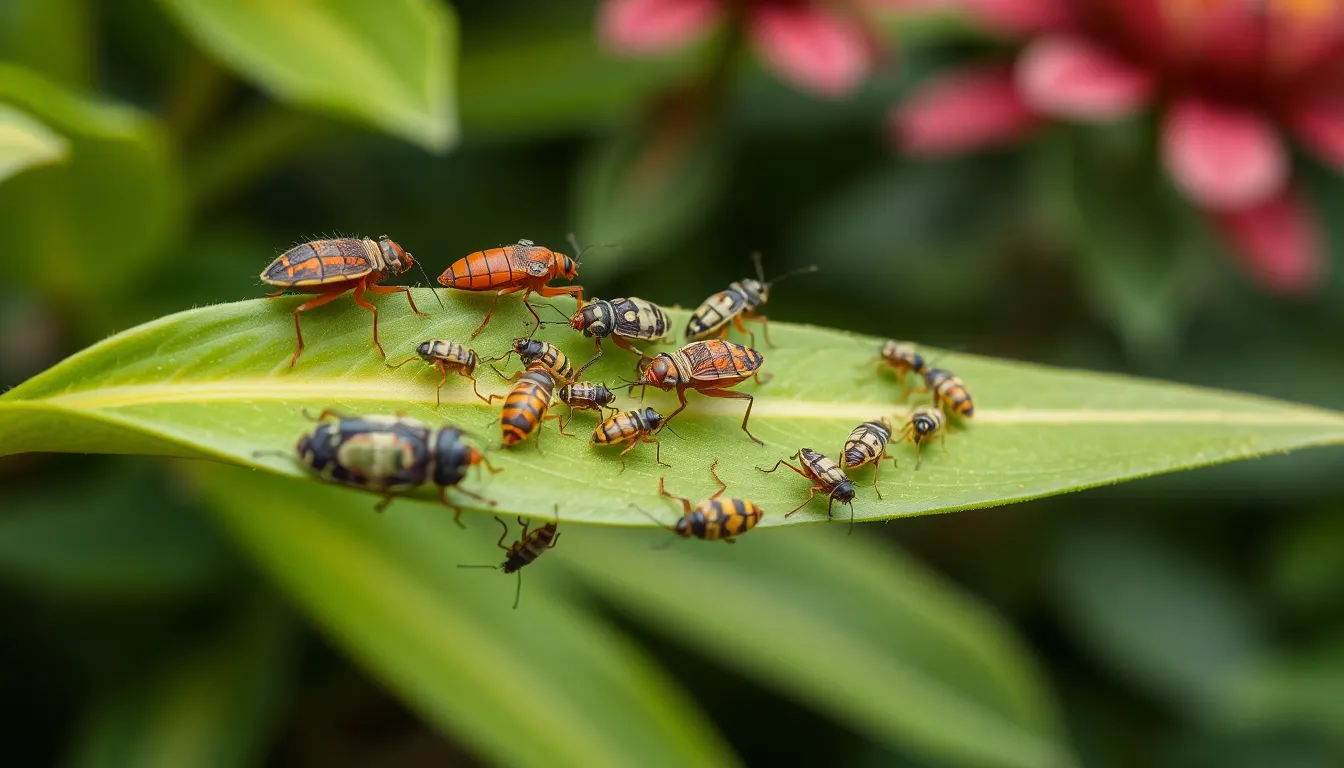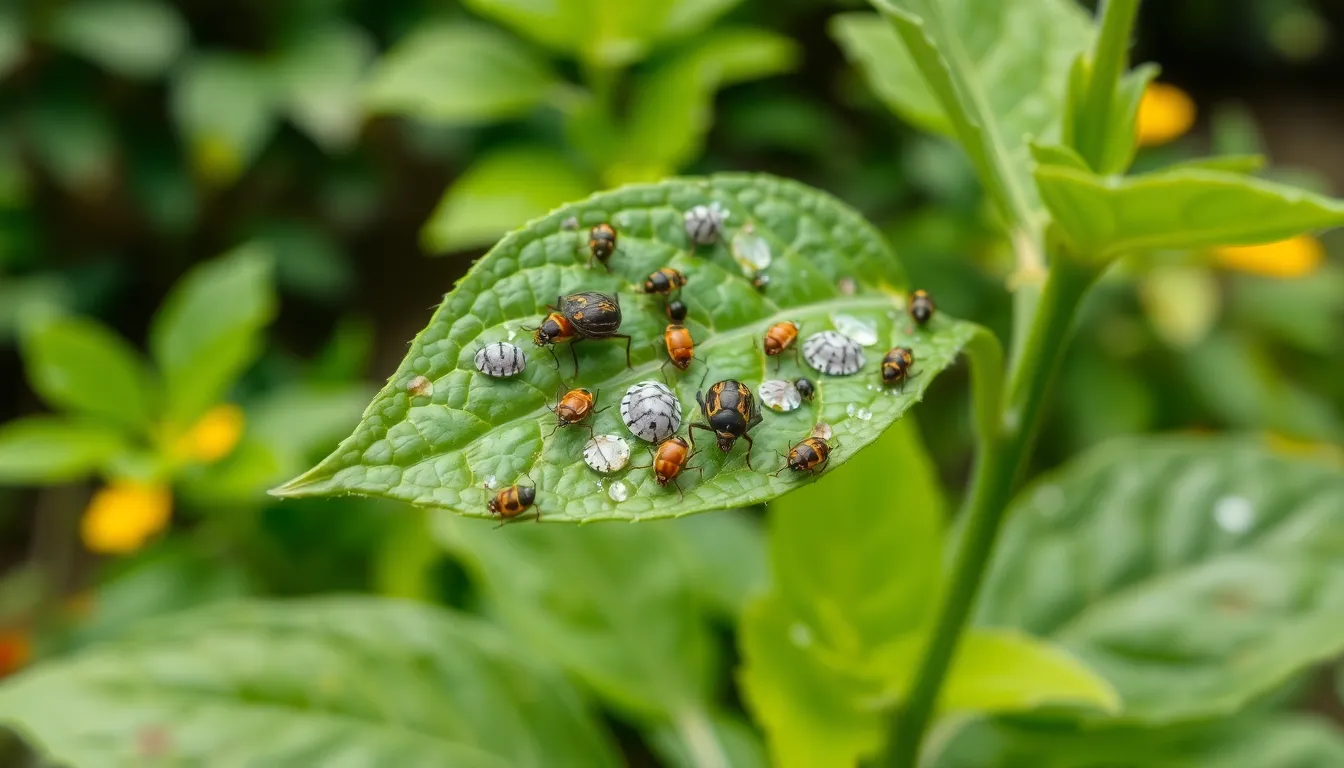Imagine strolling through your garden, admiring the vibrant blooms, when suddenly you spot an uninvited guest—scale insects. These tiny pests may look harmless, but they’re like the party crashers of the plant world, sucking the life out of your beloved greenery. If left unchecked, they can turn your flourishing oasis into a sad, wilting landscape faster than you can say “green thumb.”
Scale Insects On Plants
Scale insects pose significant threats to plant health. These pests attach to plant surfaces, often on stems and leaves, where they feed on sap. Feeding reduces the plant’s vitality and leads to yellowing leaves and stunted growth.
Identifying the presence of scale insects can be challenging. Signs include sticky residue known as honeydew, which attracts other pests like ants. Fungal sooty mold may also develop on honeydew, further impairing photosynthesis.
Different types of scale insects exist. Armored scales have protective coverings, making them harder to remove. Soft scales, lacking a hard shell, are generally easier to control but can cause equal damage to plants.
Control measures for scale insects vary. Horticultural oils suffocate pests and are effective against both armored and soft scales. Insecticidal soaps can also eliminate them, but timing of application is crucial for maximum effectiveness.
Regular monitoring of plants helps in early detection. Inspecting undersides of leaves and stems ensures timely intervention, which can prevent the spread of infestations. Maintaining overall plant health by providing proper watering and nutrition reduces susceptibility to pests.
Understanding the life cycle of scale insects aids in control efforts. Adult females lay hundreds of eggs, leading to rapid population increases. Consequently, addressing infestations early prevents larger outbreaks and protects the garden’s overall health.
Identification of Scale Insects

Identifying scale insects promptly plays a crucial role in maintaining plant health. These pests often blend in with plant surfaces, making early detection challenging.
Common Types of Scale Insects
Armored scales and soft scales represent the main categories of scale insects. Armored scales, such as the Asian citrus psyllid, possess a tough, protective covering. This covering makes control more difficult. Soft scales, like the cottony cushion scale, lack this armor, aiding easier management. Both types damage plants by feeding on sap. The effects include yellowing leaves and stunted growth, highlighting the importance of identification.
Signs of Infestation
Several signs indicate a scale insect infestation. Sticky honeydew often appears on affected plants. This substance attracts ants and encourages the growth of sooty mold. Sooty mold can obstruct sunlight, further hindering photosynthesis. Plant owners might also observe deformed leaves or visible scale bodies on stems and under leaves. Distorted growth can occur if infestations progress without intervention. Recognizing these signs early ensures timely management and protects overall plant vitality.
Life Cycle of Scale Insects
The life cycle of scale insects consists of several distinct stages. Understanding these stages aids in effective management strategies.
Reproduction and Development
Scale insects reproduce through both sexual and asexual means. Females produce hundreds of eggs, often laying them beneath their protective coverings. Eggs hatch into crawlers, a mobile stage that disperses to find suitable feeding sites on host plants. Many crawlers settle on surfaces of stems and leaves, quickly starting to feed on sap. Development continues with a series of molts, transitioning from crawler to juvenile, and eventually to the adult stage. This lifecycle can take a few weeks to several months, depending on environmental conditions.
Environmental Factors
Environmental factors play a crucial role in the life cycle of scale insects. Temperature, humidity, and host plant availability significantly influence their reproduction and growth rates. Warmer temperatures often accelerate development and increase reproductive output. High humidity levels support survival during various life stages, while drought can stress plants and make them more susceptible to infestations. Additionally, the presence of natural predators and pests affects scale insect populations, influencing their overall lifecycle success.
Management and Control Strategies
Effective management of scale insects involves several strategies. Both natural and chemical options play crucial roles in controlling these pests.
Natural Predators
Natural predators can significantly reduce scale insect populations. Lady beetles, lacewings, and parasitic wasps target scale insects at various life stages. Implementing practices that attract these predators, such as planting diverse flower species, enhances biological control. This approach promotes a balanced ecosystem, limiting the need for chemical interventions. Additionally, maintaining healthy plant conditions increases the likelihood of naturally occurring predators establishing themselves.
Chemical Control Options
Chemical control options provide immediate relief from scale infestations. Insecticidal soaps and horticultural oils effectively suffocate soft scale insects. Applying these substances during the crawler stage optimizes effectiveness. Keep in mind that armored scales may require more potent chemicals, such as systemic insecticides. Timing of applications corresponds to the life cycle of the pests for maximum impact. Always follow label instructions to ensure safe and proper usage. Regular monitoring of plant health aids in determining the necessity and timing of these treatments.
Impact of Scale Insects on Plant Health
Scale insects significantly hinder plant health by feeding on sap, which drains vital nutrients. Yellowing leaves and stunted growth often result from their presence, indicating the plants are under stress. Management can become difficult since these pests tend to blend into plant surfaces, making identification challenging.
Sticky honeydew frequently serves as a telltale sign of infestation. This substance not only attracts ants but also encourages the growth of sooty mold. Sooty mold can cover leaves, substantially reducing their ability to photosynthesize. Infestations may lead to deformed foliage, which signals an urgent need for intervention.
Armored scales are often more threatening due to their protective coverings. Control becomes more complicated with these pests interacting with their surroundings. Soft scales, while easier to manage, still present risks to plant vitality. The prevalence of both types in gardens can escalate if left unchecked.
Understanding the life cycle of scale insects aids in effective management. Their reproduction includes both sexual and asexual methods, with females capable of laying hundreds of eggs. After hatching, crawlers disperse to find feeding locations. They then develop through various stages, undergoing molts until maturity, with environmental factors playing a critical role.
Natural predators like lady beetles and lacewings also contribute to controlling scale insect populations. These beneficial insects offer a balance in the ecosystem, supporting plant health. Chemical control options provide immediate relief; insecticidal soaps and horticultural oils are effective targets during the crawler stage. Timing applications according to the life cycle enhances effectiveness. Regular monitoring of plants ensures prompt identification and appropriate treatment, helping to maintain overall garden vitality.
Conclusion
Addressing scale insects promptly is vital for maintaining a healthy garden. These pests can significantly impact plant vitality if left unchecked. Regular monitoring and early identification are key to effective management. By understanding their life cycle and employing both natural and chemical control methods, gardeners can protect their plants from these harmful invaders. Creating a balanced ecosystem with natural predators can enhance long-term pest management. Prioritizing vigilance and proactive strategies will ensure a thriving garden free from the detrimental effects of scale insects.

